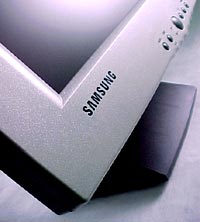We used
the monitor test program to give
the 180T's display a thorough going-over. The LCD panel proved
itself to be very vibrant in terms of colour replication and a pleasure to
work with at its high resolution and large screen size.

The panel controls are laid out in a very easy
to use fashion and are accented by the wavy design in the actual bezel. More
importantly is the fact that the display can be auto adjusted by the touch of
just one button, and settings like display input selected on the fly.
Looking at the display itself we can see first hand how
the 80/80/80/80 viewing angles performed. Looking at the display from the
side, or while standing up does nothing to distort the image quality
and representation (within that 80 degrees). That means if you look at the
display from 80 degrees up/down/left/right and the display will remain just as true as
if you were looking at the picture head on.
Brightness sits very comfortably at 220cd/m2.
This is slightly above the norm of 200cd/m2, but it is more
of an analytical comparison than anything else. I really haven't been able to visually tell the difference
between TFT panels sporting 200 or 150cd/m2 luminance ratings under normal lighting conditions.
The contrast rating for the 180T is very high at
450:1. Typically 350:1 is the high end of this scale, and 150:1 on the low
end so the 180T sits quite comfortably at the top of the line on this scale.
Finally the dot pitch of 0.28mm
gives this display a very good position, but not best of class. We have looked at other displays
with 0.264mm dot pitch and the effect is a somewhat sharper picture
(subjectively speaking).
Conclusions
I have to say it was a bit awkward getting used to
working on a 1280x1024 resolution screen that is 18.1" in size, but that doesn't
suffer from incredibly small text syndrome (from the high resolution). The
configuration is straight forward, and the auto adjust key makes short work of
it. We did have to play around with a few of our settings manually, but this
only took a moment to set before things were perfect.
 After giving the
180T a thorough going over we are quite impressed with its non-beige styling and
sheer size. When you consider the amount of electricity used by large
19" and 21" CRT displays, the move to a lower power consuming display seems
like a smart option.
After giving the
180T a thorough going over we are quite impressed with its non-beige styling and
sheer size. When you consider the amount of electricity used by large
19" and 21" CRT displays, the move to a lower power consuming display seems
like a smart option.
While it is still a relatively expensive choice to make
(the 180T retails for somewhere around $1500USD) there is a saying
that I'm beginning to hear more and more from people who have made the switch -
"Once you go LCD, you never go back." The difference in sharpness and definition
are profound, and the ease of use on the eyes is excellent.
Where LCD technology does still falter is with colour.
It is easy to forget that LCD displays are only capable of displaying about 16.7
million shades of colour. Graphic artists may want to consider holding on to
their old CRT's a little bit longer if they are doing really detailed work.
For the web, the LCD is king, and the 180T is really
worth considering, both for its looks and sheer screen size.

